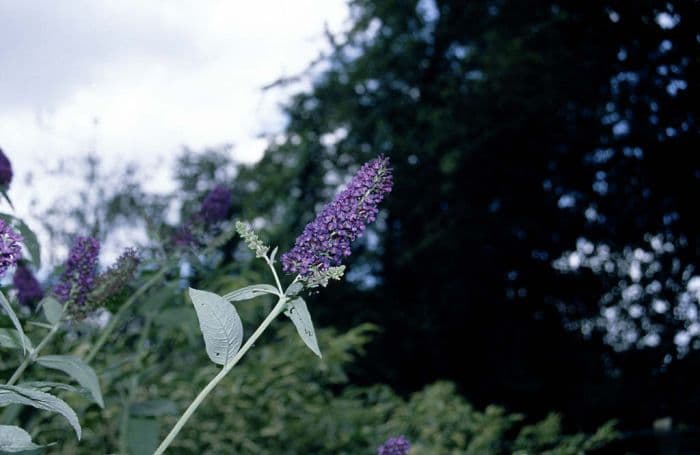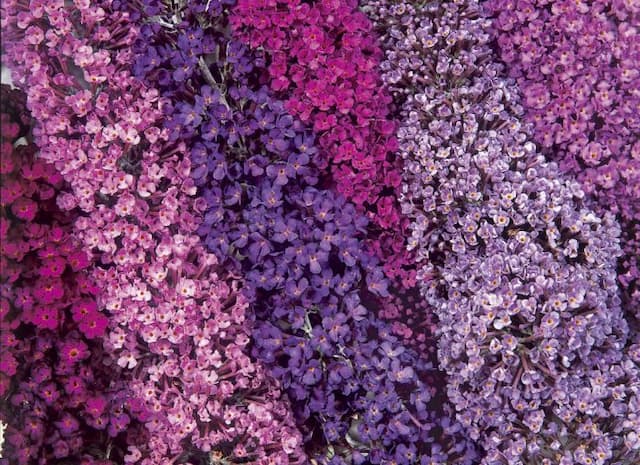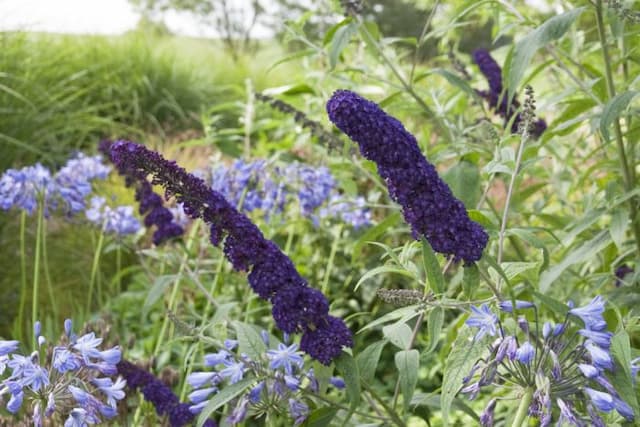Butterfly Bush Buddleja davidii 'Empire Blue'

ABOUT
The plant known as Butterfly Bush, specifically the 'Empire Blue' variety, is a captivating shrub recognized for its abundant blooms and attractiveness to butterflies. This cultivar has a dense growth of foliage, presenting leaves that are long and slender, with a pointed tip, and a lush green color that provides a striking backdrop to its flowers. The 'Empire Blue' produces spectacular flower spikes, which resemble elongated cones and are densely packed with tiny, tubular flowers. These flower clusters exude a delightful fragrance and boast a mesmerizing shade of deep blue with an orange eye that adds a touch of contrast. When in full bloom, the Butterfly Bush becomes a hub of activity, drawing in fluttering butterflies and other pollinators, lending a dynamic and vibrant atmosphere to the garden space where it's planted. Additionally, the overall shape of the Butterfly Bush 'Empire Blue' is typically rounded to slightly spreading, creating a lush and full appearance. Its branches arch gracefully, adding to the plant's visual interest and ornamental value. Despite the omission of its dimensions, one can imagine a plant that fills its space with color, life, and motion, providing a focal point of blue hues within a garden landscape.
About this plant
 Names
NamesFamily
Scrophulariaceae
Synonyms
Summer Lilac, Butterfly Bush, Blue Butterfly Bush
Common names
Buddleja davidii var. superba, Buddleia davidii, Buddleja shibatae, Buddleja variabilis
 Characteristics
CharacteristicsLife cycle
Perennials
Foliage type
Deciduous
Color of leaves
Green
Flower color
Blue
Height
6-8 feet (1.8-2.4 meters)
Spread
4-6 feet (1.2-1.8 meters)
Plant type
Shrub
Hardiness zones
5-9
Native area
China
Benefits
 General Benefits
General Benefits- Attracts pollinators: Buddleia (Butterfly Bush) is well-known for attracting butterflies, bees, and other beneficial insects to the garden.
- Drought tolerance: Once established, this plant is quite drought-resistant, making it suitable for xeriscaping or low-water gardens.
- Easy to grow: Buddleia is known for its hardiness and can thrive in a variety of soil types, requiring minimal care.
- Rapid growth: Buddleia can grow quickly, providing a sizeable presence in the garden after a short period of time.
- Long blooming season: The plant produces flowers from midsummer to autumn, offering a long period of visual interest.
- Landscape beautification: The 'Empire Blue' cultivar provides a burst of blue-purple flowers that enhance the aesthetic appeal of gardens and landscapes.
- Screening: Owing to its fast growth and bushy nature, Buddleia can be used as a natural screen or hedge.
- Versatility: It can be used in various garden designs, including borders, foundation plantings, and as a specimen plant.
 Medical Properties
Medical PropertiesThis plant is not used for medical purposes.
 Air-purifying Qualities
Air-purifying QualitiesThis plant is not specifically known for air purifying qualities.
 Other Uses
Other Uses- Buddleja davidii 'Empire Blue', commonly known as Butterfly Bush, can be used for natural dyeing. The flowers may produce varying shades of green and yellow when used in fabric dyeing processes.
- The branches of Butterfly Bush can be used in floral arrangements to add height and a wild-nature aesthetic due to their long, arching structure and attractive flower spikes.
- Butterfly Bush can be used in permaculture designs as a pioneer plant that helps to stabilize soil and create microclimates for other plants to thrive.
- The wood from Butterfly Bush is sometimes utilized in the craft industry for making small, decorative items due to its fine grain and ease of carving.
- Butterfly Bush foliage can be used as a natural pest deterrent in gardens because some pests dislike their scent and the oily texture of the leaves.
- Its dried seed pods can add visual interest in dry flower crafts and winter garden arrangements with their unique shapes and textures.
- Butterfly Bush is sometimes planted in chicken runs as both a shade provider and to stimulate foraging behavior in chickens.
- In educational settings, Butterfly Bush can be planted to attract butterflies and provide a hands-on learning experience for students studying pollinators.
- Some beekeepers use Butterfly Bush in their gardens to provide an additional nectar source for honeybees during the flowering season.
- The weather-resistant nature of Butterfly Bush's leaves allows them to be used in outdoor nature-inspired art projects and eco-printing on fabric or paper.
Interesting Facts
 Feng Shui
Feng ShuiThe Butterfly Bush is not used in Feng Shui practice.
 Zodiac Sign Compitability
Zodiac Sign CompitabilityThe Butterfly Bush is not used in astrology practice.
 Plant Symbolism
Plant Symbolism- Renewal: Buddleja davidii 'Empire Blue', commonly known as Butterfly Bush, is often associated with renewal due to its ability to attract butterflies, which are symbols of transformation and new beginnings.
- Attraction: This plant symbolizes attraction because it draws in butterflies and other pollinators, suggesting a magnetic charm or allure.
- Welcoming: The Butterfly Bush represents hospitality since its nectar-rich flowers are a welcoming food source for insects and birds.
- Carefree Growth: The rapid and prolific growth of the Butterfly Bush can symbolize a carefree or unrestrained way of life, possibly reflecting an easy-going nature.
- Resilience: Due to its vigor and ability to thrive in various conditions, the Butterfly Bush also symbolizes resilience or the ability to overcome challenging circumstances.
 Water
WaterButterfly Bush 'Empire Blue' requires regular watering, especially during hot, dry periods. For established plants in the ground, provide about 1 gallon of water per week, making sure to soak the soil thoroughly. In container gardening, water until it runs freely from the bottom of the pot, ensuring the plant's roots have ample moisture. During spring and summer, you may need to water more frequently, possibly every few days, to maintain consistent soil moisture. Reduce watering during the fall and winter when the plant is dormant.
 Light
LightButterfly Bush 'Empire Blue' thrives in full sun conditions, receiving at least 6 to 8 hours of direct sunlight daily. The ideal spot for planting is in an area that is open to the sun throughout most of the day, although it can tolerate light shade. Ensure it's not overshadowed by larger trees or structures that could limit its sunlight exposure.
 Temperature
TemperatureButterfly Bush 'Empire Blue' can tolerate a range of temperatures but prefers a temperate climate. The plant can survive minimum temperatures down to about -20 degrees Fahrenheit but thrives best in areas where the temperature remains above freezing. The ideal temperature range for optimal growth is between 60 and 90 degrees Fahrenheit.
 Pruning
PruningPrune Butterfly Bush 'Empire Blue' to maintain shape and encourage bushier growth and more flowers. The best time to prune is in late winter or early spring before new growth begins. Cut back the previous year's growth to about 10-12 inches above ground level. Deadheading, or removing spent flowers, can be done throughout the blooming season to encourage continuous flowering.
 Cleaning
CleaningAs needed
 Soil
SoilThe Butterfly Bush 'Empire Blue' thrives in well-draining soil with a pH between 6.0 and 7.0. A good soil mix can be made up of equal parts garden soil, compost, and coarse sand or perlite to ensure proper drainage. Regularly enrich the soil with compost to maintain fertility.
 Repotting
RepottingButterfly Bush 'Empire Blue' does not require frequent repotting and can be done every 2 to 3 years. Repot in spring or early summer before the onset of vigorous growth, ensuring the new pot is only slightly larger than the previous one.
 Humidity & Misting
Humidity & MistingButterfly Bush 'Empire Blue' is adaptable to a wide range of humidity levels but prefers average to low humidity environments. It does well outdoors where the humidity is natural and does not require any special humidity adjustments.
 Suitable locations
Suitable locationsIndoor
Ensure bright light, well-draining soil, and minimal pruning.
Outdoor
Plant in full sun with well-draining soil and space for growth.
Hardiness zone
5-9 USDA
 Life cycle
Life cycleBuddleja davidii 'Empire Blue', commonly known as Butterfly Bush, begins its life cycle as a seed, often dispersed by wind or animals. Upon finding suitable soil and conditions, the seed germinates, and a small seedling emerges, developing true leaves and a root system. As the plant matures, it grows into a robust shrub with woody stems and a profusion of foliage. The Butterfly Bush reaches full maturity and starts to flower typically in early to mid-summer, displaying clusters of fragrant, blue to purple flowers that attract butterflies and other pollinators. After pollination, seeds form and are dispersed, completing the reproductive cycle. In colder climates, Butterfly Bush may die back to the ground in winter, entering a dormancy stage, only to resprout with fresh growth in the spring.
 Propogation
PropogationPropogation time
Spring-Early Summer
The most popular method of propagation for the Butterfly Bush (Buddleja davidii 'Empire Blue') is via semi-hardwood cuttings. This process primarily takes place in late summer. To propagate, one would cut a healthy piece of semi-hardwood stem about 4 to 6 inches (10 to 15 cm) long, ensuring that several leaf nodes are present. The lower leaves of the cutting are then removed, and the cut end is dipped in rooting hormone powder to encourage root growth. The stem is then inserted into a pot filled with a well-draining soil mix, such as half peat and half perlite. The cutting should be kept moist and in a warm location with indirect light until roots develop, which usually takes a few weeks. After rooting, the new plant can be transferred to a larger pot or directly into the garden in a suitable spot.


![Butterfly bush [Adonis Blue]](/_next/image?url=https%3A%2F%2Fplants-admin.emdemapps.com%2Fimages%2Fplants%2F%2Fimages%2F604b56e58f983.png&w=640&q=75)


![Butterfly bush [Buzz Ivory]](/_next/image?url=https%3A%2F%2Fplants-admin.emdemapps.com%2Fimages%2Fplants%2F%2Fimages%2F604b57987dfa8.png&w=640&q=75)
![Butterfly bush [Camberwell Beauty]](/_next/image?url=https%3A%2F%2Fplants-admin.emdemapps.com%2Fimages%2Fplants%2F%2Fimages%2F604b5ead04c12.png&w=640&q=75)


